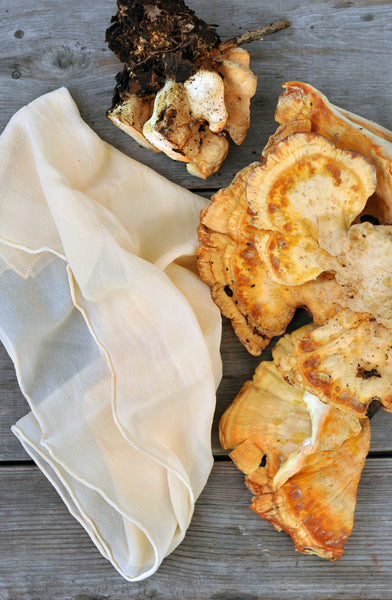
Hi Everyone! Today on the blog, Adrienne and I will teach you about dyeing with mushrooms!
I like mushrooms. Adrienne loves mushrooms. This is her favorite time of year - because here in California, it rains, and mushrooms like rain. The day after it rains is one of the best times to go mushroom hunting.This is when the mushrooms start peeking their heads out from the forest floor.
The first important thing when deciding to forage for mushrooms is to know that mushrooms can be toxic if digested. This means if you are with small children or dog do not let them touch or eat the mushrooms. It is important to wash your hands after handling mushrooms. Always use pots and vessels which are dedicated to the dyeing process - do not use these vessels to cook food.
There are specific mushrooms which are very good for natural dyeing. Dorothy Beebee and Arleen Rainis Bessette and Alan E. Bessette have done quite a bit of research on dyeing with mushrooms. Their books names' are Mushrooms for Color and The Rainbow Beneath My Feet and are well worth checking out - as they will contain information on how to dye with mushrooms and also how to identify mushrooms good for dyeing.
The recipe we will teach you today is for a mushroom called Phaeolus schweinitzii. This mushroom is also known as "Dyer's Polypore". We are using it today because it is fairly easy for us to find. And, it is found in many places across North America - so we think it could be easy for you to find too. This mushroom gives a beautiful range of color ranging from beige, gold, dark brownish orange, and brown. The color usually depends on the freshness, quantity, and amount of water you put into your dye pot. If you take good notes - as to where you found the mushroom, what time of year it is found, what size it is, and its weight - there is a greater chance you will be able to understand the color of dye you achieve.

The Dyer's Polypore hides at the base of trees or decaying wood, especially conifers. The cap of the mushroom can be anywhere from 1-1/2" - 10" wide. It usually has a fan of fused caps that are concentric in growth. It has many tubes instead of gills for dropping spores.
You can make all the colors of the rainbow just using mushrooms. Sometimes the mushrooms need a little help with pH modifiers or different mordants. This recipe is just the beginning of what could be quite an extensive research project - as it has been for us over the past five years.

RECIPE:
In order to achieve a rich color which is colorfast the yarn or fabric must first be mordanted. In this recipe, we are focusing on wool and silk fibers. To mordant these types of fiber, we use aluminum potassium sulfate. 1 tablespoon per 100g of goods to be dyed.
Recipe for mordanting:
Add enough water to a stock pot to cover the goods you intend to mordant.
Dissolve mordant in hot water. Add to water in stock pot.
Add goods to be dyed.
Add your yarn and heat. Over the course of a half hour bring temperature to 180 degrees F. Keep at this temperature for 60 minutes.
After 60 minutes, turn off heat source and let yarn cool down naturally to room temperature. Now proceed to dyeing.
Recipe for dyeing:
The ratio of mushroom to yarn should be 2:1 - in other words, if your mushroom weighs 200g, you will get a color similar to the one we have obtained in this recipe if your yarn or fabric weighs 100g.
First crumble your mushroom into a non-reactive stock pot.
Fill the stock pot with tap water to just cover the mushroom.
Place the stock pot with cover and simmer for 1 hour.
Let cool down and break apart further.
Let the mushroom soak overnight to extract the most amount of dye.
The next day heat again for another hour.
Then strain the dye liquid from the crumbled mushroom.
Then stain again.
Put strained water back in stock pot.
Add your yarn and heat. Over the course of a half hour bring temperature to 180 degrees F. Keep at this temperature for 45 minutes.
After 45 minutes, turn off heat and let yarn cool down naturally to room temperature.
Wash by hand with gentle dish soap and water, and line dry.

Voila! Here's the dyed skein of Creating - our superwash Merino, fingering weight, base yarn we created with Dyer's Polypore.
We've wanted to discuss dyeing with mushrooms on the blog and adding mushroom dyed yarn to the Verb online store for quite some time - but the release of Ysolda's newest shawl pattern, Dovana, really motivated us to get going! This shawl is part of Ysolda's series of patterns called Knitworthy - all fun, sweet patterns which would make great gifts! We love it - and she used one skein of Verb's base Creating - which we dyed with her the first time she visited Verb. See the skeins of mushroom dyed Creating here.
And to inspire you to try more mushrooms in the dyepot, we will leave you with this one last image - this is Laetiporus sulphureus, and a silk scarf which has been dyed with it, resulting in a light apricot color.

Thanks for reading!
Kristine and Adrienne
------
Tomorrow on Holiday Stitch Exchange - I give you a list of my top 10 gifts for natural dyers, wannabe natural dyers, and appreciators of natural dyes!
